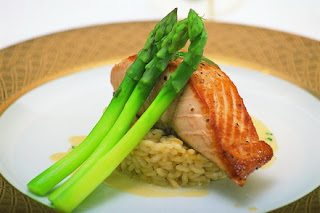I’ve come across an informative website about
Tasmania’s Top 10 under the sun. Since I love food as much as travel I decided
to share this article by Kelvin Markham about the Top 10 food specialties in
Tasmania from his website http://www.tasmaniatopten.com/
1. FARMED SALMON
Few of the world’s coastal waters are
pollution-free. Tasmania therefore has a competitive edge in aquaculture, with
one of the most pristine environments in the world and water temperatures
perfect for growing top quality salmon. Tasmanian-grown Atlantic Salmon is the
first choice for many chefs because of its flavour and texture.
An excellent source of omega-3 fatty
acids, Tasmanian Atlantic Salmon is also chock-full of vitamins and minerals,
including vitamin A, a range of B vitamins, antioxidants, vitamin D, and the
minerals calcium, copper, iron, magnesium, phosphorus, potassium, selenium and
zinc.
2. WILD ABALONE
Tiny Tasmania is the world’s largest
supplier of wild abalone. The shellfish flourish on Tasmania's wild and
tempestuous coastline, in one of the world’s last remaining unspoilt marine
environments.
Its succulent, meaty texture and
delicate flavour mean Tasmanian Wild Abalone is recognised globally as the best
on the market.
3. LEATHERWOOD HONEY
In the valleys of western Tasmania the
rainforests enjoy rainfall measured not in inches but in metres per annum. It
is here that the Leatherwood trees flower in late summer and here that
beekeepers collect the all-natural Leatherwood honey. The musky rich taste of honey from
Leatherwood blossoms is distinctly Tasmanian. Leatherwood honey is thick,
creamy and amber-yellow in colour – not as sickly sweet to taste as other
varieties of honey, but with a unique flavour and aroma.
4. BLACK TRUFFLES
The first black truffle was uncovered
in northern Tasmania in June 1999. Since then, Tasmania’s truffle enterprises
have benefited from the desire of international chefs to serve these highly
prized fresh truffles outside the traditional European season of December to
February.
French black truffles come from a
fungus which grows just below the soil surface on the roots of oak or hazel
trees. In France, pigs are used to detect the distinctive scent of the
truffles. Australian producers use spaniels and other dog breeds which they
find somewhat easier to train. (There is the added bonus that the dogs don’t
eat the truffles.)
5. SAFFRON
Nicky and Terry Noonan are the pioneers
of saffron growing in Australia. When they arrived in Tasmania from Sydney, all
they knew about the expensive spice was that it was used in making paella.
Why is saffron so rare and expensive?
Saffron is the dried stigma of the crocus flower. Each crocus flowers for just
35 days in autumn and produces one flower only. Each flower produces three
stigmas. Adding substantially to the cost is the fact that picking, stripping,
weighing and packing the filaments must all be done by hand. Little wonder that
the spice, by weight, is worth more than gold.
6. WASABI
Another boutique ingredient produced in
Tasmania is the traditional Japanese condiment, wasabi. Four local growers are
scrambling to supply the increasing demand for this spicy-hot product. It is
sold as either fresh stems or dried powder. Demand comes from top Australian
restaurants (and the Japanese embassy in Canberra), and also from innovative
Tasmanians who add the locally-produced wasabi to give a unique flavour to
mustards, pickles and cheeses. Ashgrove Wild Wasabi-flavoured cheese has won
many awards.
7. EXTRA VIRGIN OLIVE OIL
There are dozens of boutique producers
of extra virgin olive oil in Tasmania. The cool climate leads to lower yields
for growers but results in a product that is more nutritious and with a
stronger flavour. Tasmanian extra virgin olive oil has a free fatty acid level
– indicating minimal oxidation – which is four times better than the standard
set by the International Olive Oil Council.
8. ORGANIC FOOD
With today’s emphasis on a healthier
lifestyle and protection of the environment, consumers are concerned about the
long-term effects of the chemical stew used in the growth and production of
many supermarket foods. Little surprise then that organic farming and
production is a growth market for clean, green Tasmania. The State has the
largest acreage under organic farming per head of population in Australia. This
means that locals have access to an astonishing variety of organic products,
including vegetables, salads, fruit, herbs, milk, cheese, yoghurt, cream, eggs,
honey, wine, beef, lamb, chicken, olives, carrots, potatoes, beans and seeds.
9. CHEESE
It is not surprising that Tasmanian
cheese-makers regularly win top awards. They have the advantage of a clean
environment and temperate climate. Who in Australia has never heard of King
Island cheeses? In addition to the usual hard and soft varieties, blues and
bries, cheddars and camemberts, many boutique enterprises also produce
varieties made from goat and sheep milk.Tasmanian cheesemakers are passionate
about cheese – you can taste it.
10. BEEF
All beef produced for consumption in
Tasmania is free from antibiotic and hormone growth promotants, and the
majority of Tasmania’s beef cattle are grass-fed and are raised on
chemical-free pastures.
Wagyu cattle are raised in the State’s
north-west corner, mainly for beef export to Japan, but also to satisfy growing
local demand.
About Kelvin Marham:
Kelvin Markham
is a website developer, marketer and final year Law student at University of
Tasmania. He is the original author of Guide to Salamanca and The Market at www.salamanca.com.au.
He developed
the following websites, which are definitely worth your while:
DISCLAIMER: I do not claim
copyright for the photos posted above. If you happened to be the
original owner of the photos just send me a message and I shall remove
them immediately.











No comments:
Post a Comment